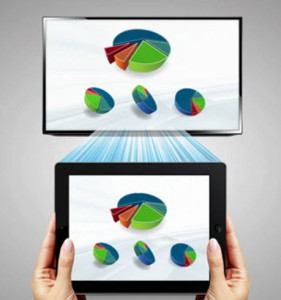Collaboration: The New Key to Success in Education and Corporate Environments
Collaboration: The New Key to Success in Education and Corporate Environments
At the same time, people have abandoned land lines and communication options that keep them tethered to a desk or an office in favor of mobile solutions such as Smartphones or tablets. In fact, the Centers for Disease Control and Prevention reports that more than 35 percent of households in the U.S. have abandoned land lines completely and fewer than 10 percent of households have no mobile communications options. Our Mobile Planet research shows that that 56 percent of the U.S has a Smartphone. Clearly, people are reluctant to remain tethered to a device or location, even for business or educational purposes.

Crestron’s AirMedia let’s you walk into a space, and easily present on existing displays with your wireless device.
We can credit the introduction of the iPad for accelerating the trend to communicating and consuming information and entertainment while on the move. Streaming services such as Netflix, Amazon Prime Video and Apple TV have also contributed to the demand for untethered media consumption.
In business and education, however, the problem is often that the physical infrastructure hasn’t kept pace with the change. Often, there is no conduit for displaying and sharing information using wireless devices. In these days of BYOD, it’s critical that companies and educational institutions find a simple method to enable collaboration and communication, including video and shared media, using nearly any wireless device.
Companies have introduced a variety of potential solutions to this dilemma. There are several emerging leaders, and each solution offers a different combination of advantages and disadvantages.
RGB Spectrum’s QuadView® HDx Multiviewer monitors offer a variety of input and output connections, provide multiple windows plus a live feed and enables panning and zooming. When combined with the Annotator, presenters can additionally highlight, draw, or paint over graphics and video. The experience is good, but might not as close to a live conference room setting as some users might like.
Barco Clickshare offers simple wireless connectivity to any user’s device and projects crisp high definition images to conference room monitors, but it requires connecting a USB device on PCs and MACs or loading an app on a mobile device.
Crestron AirMedia supports PCs, Macs, iOS and Android devices wirelessly and comes close to a seamless experience. It connects up to 32 users and allows simple switching from one user’s device to another, although it too requires loading an app onto mobile devices.
Each of these devices is state of the art and enables nearly effortless conference room sharing of documents and presentations. Each of these solutions has some advantages and potential disadvantages for use in specific collaborative situations so it’s important to evaluate all the options before making a final decision.







